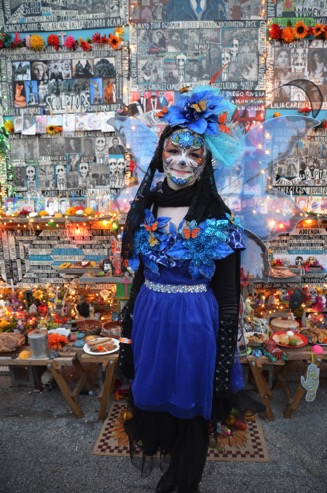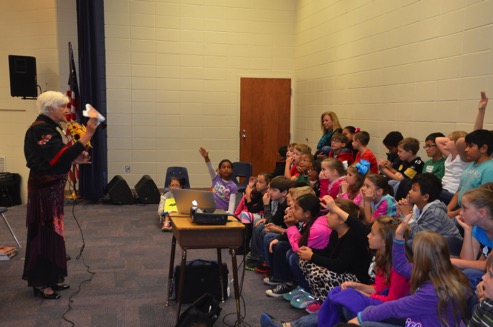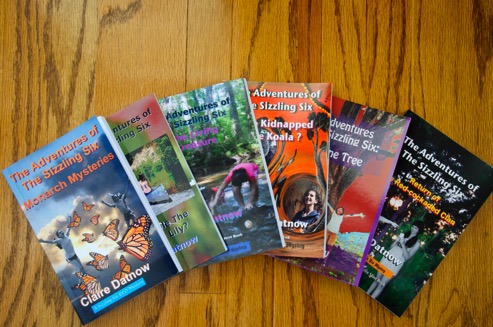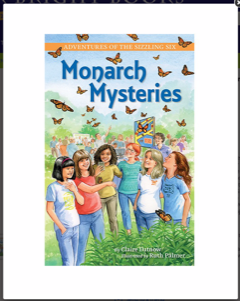YA Eco Mysteries, Memoirs, Novels & Travel
Environmental Project Based Learning
16/03/15 12:06 Filed in: Environment
How to Launch Environmental Project Based Learning
1. LAUNCH PARTY. To arouse the students’ curiosity, plan the event to be novel and dramatic. Design a presentation that encourages students to generate questions that plunge them into an intriguing ecological mystery that they must solve in order to help save an endangered species. You could invite an author of eco mysteries or non-fiction books with environmental themes. For example, for my school presentation I dress up as Mrs. Margarita Mariposa, a character in The Adventures of The Sizzling Six: Monarch Mysteries (Book Six). I wear a striking mask with flowers and butterflies, and send
paper monarch butterflies into the air.

1. LAUNCH PARTY. To arouse the students’ curiosity, plan the event to be novel and dramatic. Design a presentation that encourages students to generate questions that plunge them into an intriguing ecological mystery that they must solve in order to help save an endangered species. You could invite an author of eco mysteries or non-fiction books with environmental themes. For example, for my school presentation I dress up as Mrs. Margarita Mariposa, a character in The Adventures of The Sizzling Six: Monarch Mysteries (Book Six). I wear a striking mask with flowers and butterflies, and send
paper monarch butterflies into the air.

I ask the students to figure out the connection between the mask worn on the Day of the Dead—which traditionally is celebrated in Mexico—and monarch butterflies. This spikes the students’ curiosity. In order to make the connection, they begin to ask a barrage of questions. To help them find clues, I have students present a play-reading from a dramatic passage in my eco mystery, The Adventures of The Sizzling Six: Monarch Mysteries, accompanied by slides showing the celebration of The Day of The Dead.

By following clues and asking questions students are able to make the connection and solve the puzzle. This process, in turn, leads to the essential questions at the heart of the ecological mystery: Why is the Migration of Monarch Butterflies in Danger of Disappearing? What do we need to know about monarch butterflies in order to help save the species?
2. SELECT A SPECIES. Have students read at least one book in the eco mystery series The Adventures of The Sizzling Six to help them understand the goal of the project. Next have students select the species they want to investigate—plant or animal. You might want to narrow the selection by starting with your own county, or state. To keep the excitement alive have students dress up as their species and have a species parade involving a class, several classes, or even the entire school.

For a complete list of US endangered species see these links:
http://www.fws.gov/endangered/?s8fid=112761032793&s8fid=112762573903&countyName=Jefferson (interactive web site!)
3. RESEARCH THE SPECIES. To find the answers to why their selected species is in danger, students become Eco Detectives. To investigate clues they visit the scene of the crime (in this case the habit of the species), interview experts, carry out experiments, go on field trips, make observations in their school’s outdoor classroom, keep journals, reach out to organizations that are working to save the species, and gather information from variety of sources, including books and the internet. Students can also become citizen scientists. Monarch Watch and Journey North are just two examples where students can collaborate with conservation groups by becoming citizens scientists. Throughout the project it’s essential that students keep a record of the data they collect through note taking, drawings, photos, audio recordings, and videos.
4. DRAW CONCLUSIONS AND TAKE ACTION. To solve the Eco Mystery, students will review the problem and the results of their observations, research, experiments, and investigations. Can they find a cause for the ecological problem that is damaging their species? Once students understand the cause of the problem, then they can come up a possible solution.
5. WRITE AND PUBLISH AN ECO MYSTERY. In the story, students will take the reader through everything they did to find a solution to the eco mystery and what they can do to help save the species. At the end of my school presentation, I demonstrate how students can write and publish their own Eco mysteries by applying what they have learned throughout the research/investigative process. The final product, created with software, like iBook Author and Book Creator, is an electronic book published in the iBook store, or on Amazon’s Kindle Bookstore. Most exciting and motivating is the knowledge that their book can be shared with the school, the community, and even around the world. They book could be sold as a fundraiser to help save the species through a school project such as planting a butterfly garden. For more detailed steps follow the handout out HOW TO BECOME AND ECO DETECTIVE on my website at wwwmediamint.net.
WANT TO SHARE OR COMMENT? Please click on the icons(s) of your favorite social media to share, or to comment.

By following clues and asking questions students are able to make the connection and solve the puzzle. This process, in turn, leads to the essential questions at the heart of the ecological mystery: Why is the Migration of Monarch Butterflies in Danger of Disappearing? What do we need to know about monarch butterflies in order to help save the species?
2. SELECT A SPECIES. Have students read at least one book in the eco mystery series The Adventures of The Sizzling Six to help them understand the goal of the project. Next have students select the species they want to investigate—plant or animal. You might want to narrow the selection by starting with your own county, or state. To keep the excitement alive have students dress up as their species and have a species parade involving a class, several classes, or even the entire school.

For a complete list of US endangered species see these links:
http://www.fws.gov/endangered/?s8fid=112761032793&s8fid=112762573903&countyName=Jefferson (interactive web site!)
3. RESEARCH THE SPECIES. To find the answers to why their selected species is in danger, students become Eco Detectives. To investigate clues they visit the scene of the crime (in this case the habit of the species), interview experts, carry out experiments, go on field trips, make observations in their school’s outdoor classroom, keep journals, reach out to organizations that are working to save the species, and gather information from variety of sources, including books and the internet. Students can also become citizen scientists. Monarch Watch and Journey North are just two examples where students can collaborate with conservation groups by becoming citizens scientists. Throughout the project it’s essential that students keep a record of the data they collect through note taking, drawings, photos, audio recordings, and videos.
4. DRAW CONCLUSIONS AND TAKE ACTION. To solve the Eco Mystery, students will review the problem and the results of their observations, research, experiments, and investigations. Can they find a cause for the ecological problem that is damaging their species? Once students understand the cause of the problem, then they can come up a possible solution.
5. WRITE AND PUBLISH AN ECO MYSTERY. In the story, students will take the reader through everything they did to find a solution to the eco mystery and what they can do to help save the species. At the end of my school presentation, I demonstrate how students can write and publish their own Eco mysteries by applying what they have learned throughout the research/investigative process. The final product, created with software, like iBook Author and Book Creator, is an electronic book published in the iBook store, or on Amazon’s Kindle Bookstore. Most exciting and motivating is the knowledge that their book can be shared with the school, the community, and even around the world. They book could be sold as a fundraiser to help save the species through a school project such as planting a butterfly garden. For more detailed steps follow the handout out HOW TO BECOME AND ECO DETECTIVE on my website at wwwmediamint.net.
WANT TO SHARE OR COMMENT? Please click on the icons(s) of your favorite social media to share, or to comment.


